03.27.21
Posted in Canadian life, Health, Married life, Random thoughts, Travel at 3:15 pm by ducky
My beloved and I, at my instigation, took a little vacation on Friday. I wanted to celebrate finishing our taxes, the weather had been beautiful and sunny (although still slightly cool, c’mon, it’s British Columbia in March), and we hadn’t been out at all together in a very long time.
So we rented a carshare, ostensibly to cruise around and look at cherry blossoms.
But of course there was scope creep. Oh hey, if we look at cherry blossoms out at UBC, then we should get takeout from my fave campus restaurant and eat at the little park next door. And of course get ice cream from my fave ice cream shop. Oh, and if we have a car, we should go visit J&A (distanced, in their back yard), who my beloved hasn’t seen in person for a year. And because they can’t invite us in, let’s get takeout on our way home! Oh, except beloved as a doctor’s appointment at 3pm, so we’ll need to add that in. Oh, and as long as we have a car, we should pick up bulk kidney beans and yellow raisins at the Punjab Food Centre.
We are still in a pandemic, so there were a few things that we knew would be different, even in the planning stage. In Before Times, maybe we would have stayed at J&A’s for dinner. In Before Times, we would have eaten at the restaurant. I also carefully checked fave restaurant’s web site to make sure they were still open.
I gave a passing thought to toilets. We should probably pee at fave restaurant at lunch. I considered whether that was safe, and decided it was. Their washroom was relatively large and lightly used even when in Before Times.
Well. When we got to fave restaurant, there was a sign which said that it had closed on 7 Dec. Grrrr, thanks for keeping your website updated, not.
And I needed to pee!
The UBC hospital is very close, so we headed over there. I felt a little bad about sneaking in, but I had been a patient there before, and I really did need to go. But a sign which said, “NON-ESSENTIAL VISITS PROHIBITED.” While finding a toilet was essential for me right then, I was pretty sure they wouldn’t find it essential. I could not enter in good conscience, even though I was wearing a good mask.
So instead, we went to the UBC Health Clinic, where we are both current patients. They have big washrooms with low usage, so I felt pretty sure it was safe. Success!
That gave us enough breathing room to find a fast food joint near the ice cream shop. We ate a leisurely lunch outside, had ice cream outside, and then… I needed to pee again. After a little bit of discussion, we decided to swing past home and pee there. (It also let my beloved pick up his wallet, which he had forgotten at home because he doesn’t go out that much because pandemic.)
I thought about staying home and having him swing around afterwards and pick me up, but then decided that if I went with him and waited in the car (because pandemic), then we could head straight over to J&A’s.
Did I mention that my beloved got the food at the restaurant? And so when I asked for a cola, dutifully got me a cola? Which came in a 591ml bottle instead of the 222ml mini-cans which I usually drink?
Yep, after Jim got done with his doctor’s appointment, I had to pee again. And since J&A couldn’t let us in their house…. yep, we swung past home again.
After we left J&A, I was able to hold it until we got home, but I was definitely paying attention to my bladder.
“You have to plan potty breaks really carefully” is not the pandemic advice I ever expected during Before Times.
Permalink
12.05.10
Posted in Family, Travel at 9:41 pm by ducky
As our most recent — and final — instalment of our rent-a-nephew program, we took two nephews to Turkey this summer.
Turkey was surprisingly difficult for us to travel in because we didn’t speak the language. I realize that that’s probably how it goes for most tourists, but we have generally been able to have *some* facility in the local language. Even when we went to Bali, we were able to learn some rudimentary grammar and vocabulary. This time, in part because Turkish is so hard for an Indo-European speaker and partly because we were *so* busy before the trip, we couldn’t really say more than “hello”.
Also because we were busy, we did essentially no planning ahead of time. Jim booked us a hotel for the first three nights in Istanbul, but aside from that, we had no itinerary. For the first two days, Jim and I discussed (with some input from the nephews) what we were going to do and how we were going to accomplish it. Note that “discuss” is a somewhat polite word.
Eventually, we admitted defeat and decided to throw ourselves on the mercy of a travel agent. We looked around on the Web for recommendations, and ended up going with Turista Travel. We walked in, told Davut who we were, what we were looking for, and he basically arranged everything.
The basic style of the trip he built for us was a sequence of mini-packages. “Package tour” had always sounded to me like “two weeks on a bus with 50 other rich old white Americans”, but that’s not the flavour of the trip. Instead, most days on the Turista-arranged tour went like this:
- Wake up at a decent, clean but not opulent hotel.
- Have breakfast at the hotel’s breakfast buffet (food included, drinks extra).
- Get picked up by a minivan that would carry a driver, a guide, and 2-6 other tourists, usually Europeans.
- Go to a cultural site, where the guide would show us around.
- Go to a banquet center (which our nephews quickly dubbed “Tourist Feeding Centers”) with (food included, drinks extra) with adequate but not super-tasty food and chairs with bows on the backs, filled with other rich white overweight tourists.
- Go to another cultural site, where the guide would show us around.
- Go back to the hotel *or* get sent on to the next hotel. Note that they arranged ALL the pickup / drop offs.
- Have dinner at the hotel’s buffet (food included, drinks extra).

A Tourist Feeding Center in Turkey
This was not always the exact schedule.
- Sometimes the guides would take us to a really yummy place for lunch. Lunch costs came out of their profit, but they allowed as how they could only handle so many meals at the Tourist Feeding Centers. Those meals were usually really, *really* good (as opposed to adequate at the TFCs).
- Sometimes the guides would take us to commercial artistic establishments where we would get demonstrations of how crafts (e.g. rugs, pottery) were made, and be given the opportunity to buy stuff. We believe the guide got a kickback for bringing customers to the factory, but the demos were generally pretty interesting, and the pressure wasn’t too bad to buy.
- We went on a four-day boat trip where the rhythm was to go to anchorages and swim instead of getting tours of cultural sites. (The boys loved that part; I was bored.) (Food included, drinks extra.)
By and large, the trip went very smoothly. It was not perfect:
- One day the minivan broke down going over the mountains, and we lost an hour or two while they arranged a different van for us.
- One day our package was subcontracted to a different vendor, but we didn’t know that, so at the pickup, we were looking for “Turista” and the driver was looking for people looking for “Beach”.
- One day, there was some confusion about which bus we took, when, and where the tickets were supposed to come from. The hotel’s English-speaker was on vacation, plus we didn’t realize we already had the tickets, etc.
However, in the first case, it wasn’t anybody’s fault, in the third case we were at least partially to blame, and in ALL cases, the staff worked hard to make it right. (When we got back to Istanbul, I stopped by the Turista office and Davut tried to refund our money for the bus ticket; I insisted that we only take half because it was partially our fault.)
We might have been able to do the trip cheaper ourselves, but it is more likely that it would have been more expensive if we had done it “a la carte”, and I am sure that we would have encountered more frustration and seen less if we had done it ourselves. I am pleased with Turista and would recommend them to all but the most experienced or frugal travellers.
We spent three days in Istanbul at the beginning of the trip and two or three at the end of the trip on our own, and did mosque and museum crawls which I found quite interesting. We also ate really, really well. The food in Turkey is really, really yummy in general.
The cultural sites were great from my point of view; the swimming was great from the boys’ point of view. My take on those is probably no more interesting or insightful than any other travelogue you can find on the Web for the most part. I will give you only a few points:

smartphone vs. cuneiform tablet
- We made a special effort to stop in the capital, Ankara. It’s not on the usual tourist route; apparently there’s not much there. However, they do have an amazing museum there that were quite interesting to someone interested in old writing systems. In particular, they had lots of cuneiform tablets. I had always thought of cuneiform tablets as being like the tablets that Moses is shown carrying in cartoons: about as tall as waist-to-chin; a bit wider than a torso. Well, to my surprise, they are about the size of iPhones, and the script is TINY. The script was made by pressing the ends of reeds into clay and the reeds were basically the size of small grass blades. I guess it makes sense: iPhones fit nicely in the hand, and one would probably want a cuneiform tablet to fit nicely in the hand.
- Also at that museum, I saw artwork that seemed to be between cave paintings and stylized Greek art. I found that fascinating: I had never seen quite that niche of art before.

Art between cave paintings and Greek urns
- As everyone else who has been to Turkey will tell you, the Turks are very very friendly, especially rug salesmen who want to show you their wares. However, something very interesting happened: they were on us like flies when we were in Istanbul at the start of the trip, but much less when we returned at the end of our trip! Someone suggested that we walked differently or gazed differently, but I don’t think that was it: I think we were pasty white at the start of the trip and suntanned at the end of the trip. So if you want less hassle from the rug vendors, catch some rays before you go.
Best anecdote of the trip: there was some commotion at a restaurant we were at. The woman at the table behind me was complaining loudly that she had complained three times “Excuse me, this is rubbish” to a busboy and said busboy did not bring the manager so she could complain about the food. (Excuse me, that’s HIGHLY colloquial English!) The manager (who eventually showed up) pointed out that the busboy didn’t speak English well. The woman then exclaimed, “How do you expect to serve the public if you can’t even speak the language???”
I was pleased that my nephews both immediately had to stifle laughter and also pleased that the woman was British and not American. 🙂
Permalink
08.17.09
Posted in Travel at 7:36 pm by ducky
(See also part 1 and part 2 of my Africa postings.)
It’s sort of cliche to say, “the thing I liked best about county X was the people”. We said that about the people in Quebec City, for example. The people in Botswana, however, take it to a whole different level.
There is a concept in southern Africa whose name in Zulu you might be familiar with: ubuntu, or in Setswana botho. It’s not just an operating system, it’s a philosophy of life, almost a religion. The word encapsulates generosity, warmth, openness, and acceptance, but also an acknowledgment of the interconnectedness of all people.
Botho/ubuntu is highly valued in southern Africa; in North America, not so much. I’m not saying that North Americans think that warmth, generosity, openness, and acceptance are bad things, just that they are not valued as highly as other things — like getting the job done quickly and cheaply.
One concrete manifestation of this is that all transactions start with an inquiry about the other: Hello/hello/how are you/fine, how are you/fine, thank you. While this happens in North America, too, you by and large don’t say it to strangers. In North America, when it is your turn to get served, you just say what you want: “One ticket to District 9, please.” Not so in Botswana: all transactions get the full greeting.
Furthermore, while I can’t prove it, I think the Batswana (people of Botswana) mean it.
Valuing botho leads Batswana to be nice, but also it seems like they feel it is their patriotic duty to make sure that tourists have a good time. Botswana has three basic sources of foreign currency: diamonds, cattle, and tourism. That’s pretty much it, and everybody knows that. Everybody understands that diamonds, cattle, and tourism are what funds their roads, their health system, their universities, etc. Thus it is important to the health of their country that tourists keep coming back.
Botswana is also a very small country: 1.7 million people in a country roughly the size of Texas (which has 24 million people). In addition to connections being important (see botho above), everybody knows everybody. (We stopped at a random fast-food place in Francistown at one point, where our Motswana friend B. had lived for about four years, eight years ago. Of the ten or so people in the restaurant, B. knew three. At the hotel we stayed at in Kasane, B. knew one of the desk clerks.) Even if a Motswana doesn’t work in tourism, somebody they know will work in tourism: their brother / sister-in-law / cousin / cousin’s husband’s nephew, somebody.
Finally, Botswana is a politically stable, relatively prosperous country. Botho doesn’t get sacrificed to sectarian violence, nor to hunger. I didn’t see any beggars in Botswana, and the only street hawker we saw had come over from Zimbabwe. (South Africa and Zimbabwe are not prosperous countries, and we did see street hawkers in both of those countries.) There was zero reason to fear getting beaten for my political beliefs, and I never worried about getting mugged.
I was profoundly affected by how nice the people in Botswana were. It was a little bit jarring to come back to the USA, where I wasn’t really supposed to ask gate clerks how they were, and certainly wasn’t supposed to care. I find myself much more wary in North America, with our high number of beggars.
I think that Canadians value botho a bit more than people in the US. So oddly, I think that going to Africa made me a little bit more Canadian!
Permalink
08.05.09
Posted in Family, Travel at 6:05 pm by ducky
Of all the charismatic megafauna in Botswana, elephants are perhaps the most charismatic and definitely the most mega. We are also friends with Jake Wall, an elephant researcher working with Save the Elephants (see the National Geographic article that he’s featured in!), so we probably knew more about elephants than any other of the Botswana animals. Good thing, as we saw lots of elephants. LOTS of elephants. I am certain that I saw at least one hundred, and maybe two or three hundred.
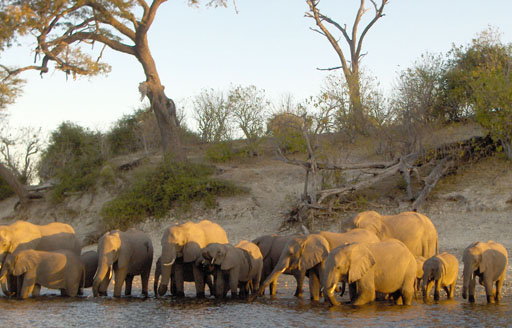
We saw the biggest herds from the Chobe river next to the Chobe National Park, near Kasane.

There are 50,000 elephants in the 11,700km² park, and in the dry season, many of the ones in the north go to the river in the late afternoon to drink. There are so many elephants there that there are practically traffic jams!
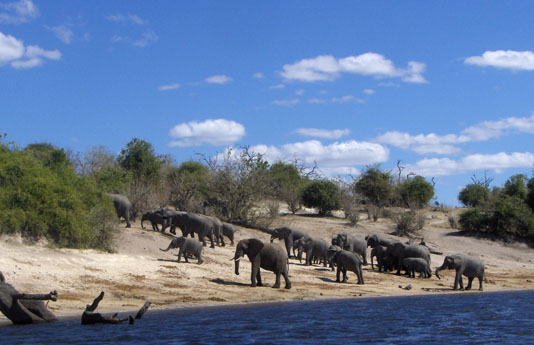
Not only that, but the herds do not run away from tourists in boats. I don’t know if they are just habituated to tourists and how much of it is that groups of primate predators in boats aren’t as threatening as groups of primate predators on land. (How do they know we are predators? Predators have eyes that face forwards.) The elephants kept wary eyes on the boats, but they weren’t spooked enough to move away. Later on the safari, we mostly got to watch animals’ backsides as they moved away from the scary tourists; the river cruise was one place where we saw their frontsides.
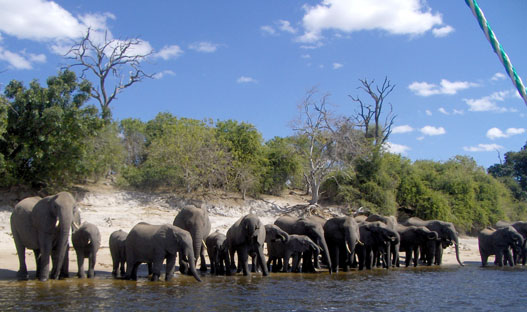
In the same way, because we were in boats, the elephants weren’t a threat to us. That meant that the boat captains could bring us quite close. I estimate that we got to within four or five meters of elephants (and crocodiles and hippos!) sometimes.
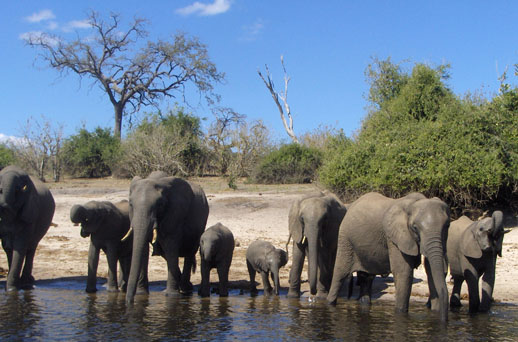
On our second river cruise, a bachelor herd (males only) swam across the river RIGHT IN FRONT OF US. I knew that elephants could swim, but was quite surprised at how they swam. Unlike dogs or horses, their heads are almost completely submerged and their bodies are completely invisible. All you can see is a little bit of trunk, acting as a snorkel, and the tops of their heads. Their heads rock forwards and back as they swim.
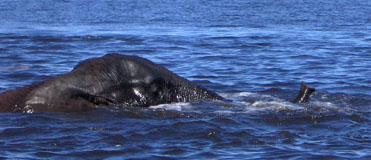
Elephant swimming across Chobe river
All fourteen of the bachelor herd got into the water, but one young male turned abruptly back after walking in up to about his shoulders. Our guide surmised that he was new to the area and afraid of the water. As we left, he was wandering back and forth on the shore, looking across the river at his buddies. I imagined him feeling bereft and forelorn, hating being separated from his herd but also afraid of the dark waters in front of him.
His buddies, once they got across, pulled up hunks of the tall grass in the marshy land on the other side and for all the world appeared to spank the ground with it, then eat it. Our captain explained that they were knocking the dirt off of the roots. (They maybe were standing in a little bit of water — hard to tell from a distance when marsh grasses were everywhere.) When an elephant dies of “old age”, it is usually from starvation. Either the teeth wear down to unusable or they fall out, and then the elephant can’t chew its food adequately. If they knock the dirt off, then that saves wear and tear on the teeth.
On the other hand, sometimes elephants would eat dirt. Yes, really. There are some minerals (like salt) that aren’t plentiful enough in their food, so they will dig holes and eat the dirt. (They might not chew the dirt, I suppose, so perhaps that dirt doesn’t wear down their teeth.)
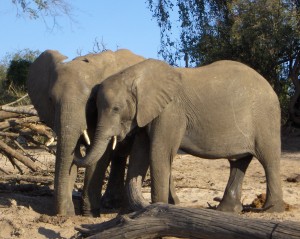
Elephants feeding each other dirt from a hole they dug
The first pictures, of the elephants at the riverbank, are mostly “breeding herds” — composed of females and juvenile males. As soon as a male starts getting overly friendly with the females in the herd, the mother forces him out! I sure hope that elephants have complex language, as otherwise it seems like it would be a horrible, horrible shock. Imagine being a boy who spends every minute of every day with the same twenty family members, and as soon as your mom sees you checking a girl out, she forcibly runs you out without telling you why! Imagine then having to find a group of other lonely males — with presumably a different social structure — and try to fit in.
The bachelor herds we saw had a range of ages hanging out together. We heard that the younger bulls learned how to do things from the older bulls. (Presumably like how to cross rivers, and also where the good water holes are.)
Bulls do not always hang out together; sometimes they go off on their own. Not being an elephant psychologist, I don’t know if they are socially maladept, bored, tired of being around younger bulls, tired of being around older bulls, or what. Maybe those anthropomorphic emotions don’t even make sense for elephants.
We did observe two elephants being affectionate (or at least intimate) with each other, feeding each other dirt from a hole they had dug — see photo above.
It was not uncommon to see lone bulls — occasionally at very close range!

Jim responding to cries that there was an elephant in our camp
We were taking a siesta in our tent when we heard people shouting that there was an elephant in our camp. We weren’t sure if we were safer inside the tent our outside, and eventually chose to get out of the tent, only to discover that the elephant was only five meters away!
This bull was after seed pods from the camelthorn acacia tree in our camp. He put his tusks around the tree, carefully laid his trunk up the tree trunk, and shook the tree, making pods rain down. He hoovered the area of pods and then sauntered off, totally nonchalant and disinterested in us.

Bull elephant harvesting camelthorn acacia seed pods
I was surprised at just how quiet elephants are when they walk. As I mentioned above, the elephant in our camp was 5m away and we never heard him. Not a thing. They are so big that you’d expect the ground to shake as well, sort of like a truck going by, but no, not a thing. When walking, they have three feet on the ground at any one time, and have big poufy feet, so they are incredibly stealthy. Here’s how big their feet are compared to mine:
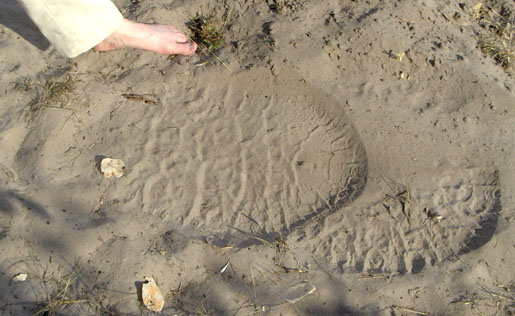
Tracks of the elephant that went through our camp
Later on the trip, Jim and I heard a great deal of splashing around while we were visiting the camp latrine, which that night only had distance as its privacy guard. The splashing noise went away before we finished up, and on our way back we encountered a (very uncomfortable/embarrassed) guide who wanted to warn us that an elephant had swum across the river and landed right near us, but didn’t really want to intrude upon us in the latrine! Once the elephant got out of the river, we heard nothing, even though the splashing sounded quite near.
Did that frighten us? No. Maybe it should have, but it didn’t. The elephant that passed the latrine could probably smell us (and the latrine), we were not advancing upon it, it would have to go through some bushes to get to us, and elephants are usually not aggressive unless they are in musth (a condition similar to erustrus in females, characterized by extreme randiness, aggression, and a strong and distinctive odor) and we didn’t smell anything funny. We also only heard one animal splashing, which meant that it was unlikely to think we were threatening its child.
We did see adult females protecting a baby elephant quite fiercely a few days before: note that there are four adult females forming a defensive ring around the baby, barely visible (cyan arrow points to its tail). They were also trumpeting and flapping their ears.
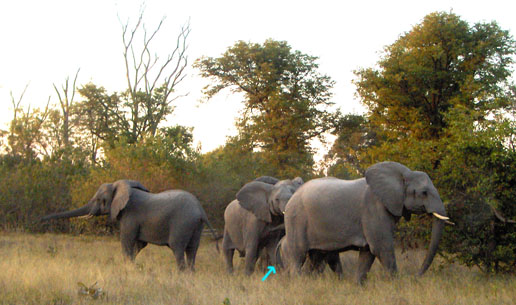
Four female adults protecting one baby elephant
While elephants’ walking is nearly silent, the same cannot be said for their crapping. Their dung comes out in volleyball-sized balls, and like horses but unlike dogs (or lions, as we observed later), elephants don’t stop and squat to defecate, but just lift their tails and keep on walking. That means their dung falls from a great height — two or three meters up. Boom! Boom! Boom!
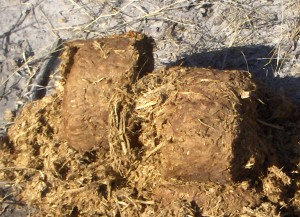
Elephant dung
The shape is such that, well, I will never look at Rolo chocolates the same way again.
On our river cruise, we were quite surprised to see baboons apparently eating elephant dung. Our guide explained that elephants have poor digestive systems. (Elephants pass so much fiber in their dung that people make paper out of it!). Their digestive system is so poor that frequently it lets fruit and nuts escape undigested. Baboons would thus root through the elephant dung in order to find those fruits and/or nuts.
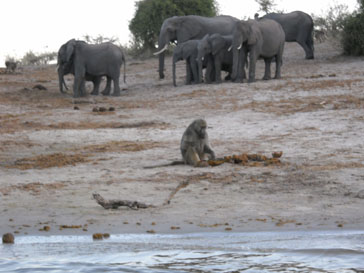
Baboon eating elephant dung
As you can see, I was fascinated by the elephants.
Permalink
Posted in Family, Travel at 5:42 pm by ducky
Jim and I, having no kids of our own, borrow nieces and nephews when they turn (about) fourteen. We had a friend from Botswana who encouraged us to visit, and The Niece was up for it, so we went to Africa! This post talks a little about where we went, how we got there, where we stayed, what the accommodations were like, etc. This post will have almost no observation/analysis/personal notes: it probably isn’t that interesting unless you really like Jim and/or I, or you are planning/thinking about a trip to Botswana yourself. (See the next postings for analysis and personal notes.)
We spent twenty-four days total away from our home, although we spent about seven days getting there and back: one day from Vancouver to Seattle (via Bellingham to pick up The Niece), one night to Frankfurt, one day in Frankfurt, one night to Johannesburg, one day drive to Botswana, and then the reverse (except we flew to Jo’burg instead of driving).
The Safari
The centerpiece of the trip was a seven-night/eight day overland (i.e. driving) safari with Chobezi, camping for one or two nights in one place, then driving to the next interesting place. We travelled in a group of eight: us three, two Belgian men in their early twenties, one guide/driver, and one cook.
We found and booked the trip online (and when I say “we”, I mean “Jim”), with what turned out to be a South African booking agency. This meant that we knew very little about what the safari would be like. We knew where we would be stopping, and we knew that we were going overland and camping in tents with foam matresses, but that was all we knew. We knew so little that we even had trouble rendezvousing with Chobezi at the pickup point!
We camped at four places: at Serondela and Savute Marshe in the Chobe National Park, Moremi Game Reserve, and an island in the Okavongo Delta.
A typical “moving” day would have us get up around 0630h, eat breakfast, pack our gear, tents, and sleeping rolls, wait for the guide and cook to pack everything else (they turned down help), and drive to the next site, looking for game along the way. We’d set up our tents and bedrolls, then take a siesta, sunbathe, hang out, whatever, until about 1630h, when we’d do an evening game drive before dinner. A non-“moving” day would be the same except that we’d go for a game drive early in the morning and not tear down/set up camp or drive to the next site.
We rode around in a “safari car” or “safari truck” — a converted Land Cruiser with elevated bench seats. The truck we used on our safari has five seats plus some storage in the back, plus it hauled a trailer full of stuff when we moved camp. I believe most safaris rely more heavily on airplanes to get people from one place to another; I don’t recall seeing another safari car with storage.

Our safari car
Here are some other safari cars:

Some other companies' safari trucks
The tents were quite big. The Niece and I could stand up in them.

Ducky Standing up in tent
I had never seen bedrolls these before: they were relatively thick foam matresses, with sheets, pillow, and a comforter placed on them, that we could zip up and roll up.

Bedrolls unfurlled (L) and in bondage (R)

Bedrolls rolled up
The tents and bedrolls were heavy, but because we were car camping, it didn’t matter.
Camp hygiene
The camp had a it latrine with a toilet seat frame over it, and canvas walls set up around it. Jim once commented that in terms of value per ounce, the toilet seat was way, way up there!
Next to our tents they put little canvas bags that served as wash basins. Every morning, they would put hot water in the basins for us to wash with. That was really nice!
We also didn’t realize it until near the end, but we had a shower available as well. Apparently the first day, our guide asked me if I wanted a shower. “Maybe later”, I said, and he waited for me but I never got around to asking. I don’t remember this: probably I thought he was kidding. (A shower? While camping?)
At our second stop (at Savute Marsh), we stayed in a campground, with hot showers and sinks and flush toilets and everything. They also had neat washbasins with built-in washboards, so clearly you were allowed (encouraged?) to wash your laundry in the sink.
There were probably twenty campsites at the Savute Marsh campground, filled mostly with self-driving South Africans. You would think that would impede the wildlife viewing, but in fact did not, as you will read about in my elephants post.
Camp food/cooking
Cooking was done on an open fire. They brought along something that looked like an iron coffee table, and put that over the fire.
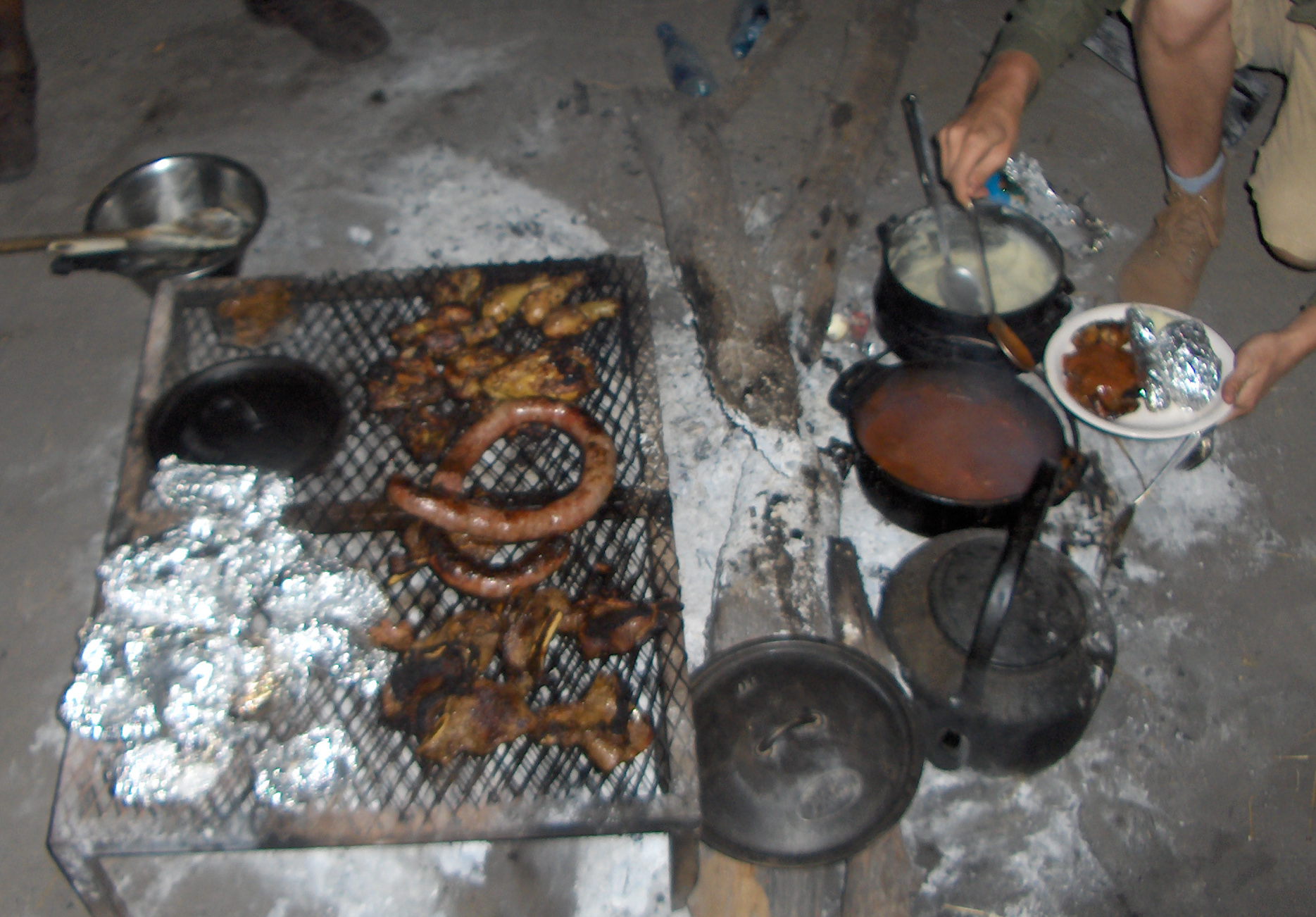
Kitchen facilities
Breakfast consisted of cold cereal, tea, porridge (oatmeal), and fruit. On moving days, lunch was usually sandwiches (cold cuts), potato salad, and fruit. Dinner was always a hot meal, with a meat course, starch (potatos, rice, or “pap” — sort of corn/maize porridge), and a vegetable dish (e.g. carrots and potatos). The food was really, really yummy — the cook did a great job.
Jim and I normally try to eat vegetarian, with Jim being better at sticking to his values than I. I wimped out and ate the meat in Botswana because it was just easier. (Jim had told the South African booking company that we were vegetarians, but that piece of information never got to the guides.) Jim just didn’t eat the meat for a few days. The cook and guide noticed, and asked Jim, who said that he preferred to not eat meat.
The next day, the cook announced that “for the man who does not eat meat, I fixed something special.” With a flourish, he revealed… chicken! (In many languages, “meat” means “mammal meat”.) Faced with that level of attentiveness and care to his needs, Jim (sigh) ate the chicken.
Mokoro camp
For our last two days, we said goodbye to our driver (although we kept our cook) and went out to an island in the Okavango Delta by boat(s). First we took a speedboat to the Boro village, where we transferred to mokoros — poled dugout canoes — for a two-hour water voyage to our camp.
Getting ferried by what are essentially African gondolas sounds very romantic. The reality was less so. The boats were very tippy, so you had to be careful about shifting around. The seats were basically institutional plastic chairs with no legs, just dropped into the boat, so weren’t that comfortable. We went there in the afternoon and came back in the morning — and the camp was west, so we had the sun in our eyes both times. Perhaps because it has been an extremely wet year, there were thousands of gnats, which hovered right at sitting-person-level. To catch the gnats, many water spiders built webs right at sitting-person-level. (Note: neither the gnats nor the spiders bit. They were just annoying.)

Gnats during Mokoro ride
One of the Belgian youths turned his seat around so that the back of his head caught the gnats and spiders, and the sun was not in his eyes. That would have been much more pleasant. Going out in the morning and back in the afternoon would have also been more pleasant.
We went on a game walk on the island, something that we couldn’t do elsewhere. In other areas, we had been pretty much stapled to the truck because of the small but real danger from lions. While we did get a safety lecture before our walk on what to do if we encountered lions, hippos, snakes, or wildebeests, I presume that the dangerous animals are rare on that island. (We did not see any lions, hippos, or snakes, and the wildebeest were a long way away.)
It was nice to get some exercise, and we saw larger herds of animals than we did from the safari truck. (The truck is noisy. It can’t really sneak up on a herd the way we could on foot.) However, we couldn’t get as close on foot, in part because of the need to be stealthy, in part for safety reasons. While we saw lions from several meters (and in one case, ONE meter, see below) from the truck, on the walk we were usually more like 500m or 100m from herbivores.

One example of how close we got in the truck
We also didn’t see much on the walk that we hadn’t already seen from the truck, aside from an aardvark den (a hole in the sand).
The locals who guided or poled us to the island did sing and dance for us on the second night, and we got a mini-tour of their village, and that part was nice. Aside from that, however, I could have done without the Okavongo Delta part of the tour.
Non-safari
We spent several days in Gaborone (“Gabs”), the capital. We ran out to tour the diamond mine in Jwaneng the day after we landed (since the mine only gives tours on Fridays). The mine could have been any heavy equipment plant in North America, except that the second language was Setswana and not Spanish (US) or French (Canada) and there were two more baboons than I would have expected in North America.

Ducky looking out over open-pit diamond mine
We spent the weekend wandering around Gaborone — checking email, letting Katie run on a treadmill at a gym, shopping for things the airlines ban, buying local GSM chips for our cell phones, trying and failing to find local maps, wandering around shopping malls and bazaars — and waiting for our friend B. We were supposed to leave Gabs on Sunday, but our friend B. sadly had to go to a funeral on Sunday, so we had an extra day in Gabs.
We were going to go to the Khama Rhino Sanctuary in Serowe, but because of the funeral, we had to cut something, so we cut the rhinos. We found out later that our friend B. is from Serowe; had we realized that, we would have cut something else.
Serowe is also the hometown of Sir Seretse Khama, the first president of Botswana. Botswana is, unlike its neighbours, a bastion of peace and (relative) prosperity, in large part due to this one amazing man. Please pause now and read his Wikipedia entry before going on to my next Africa journal blog posting.
Permalink

























